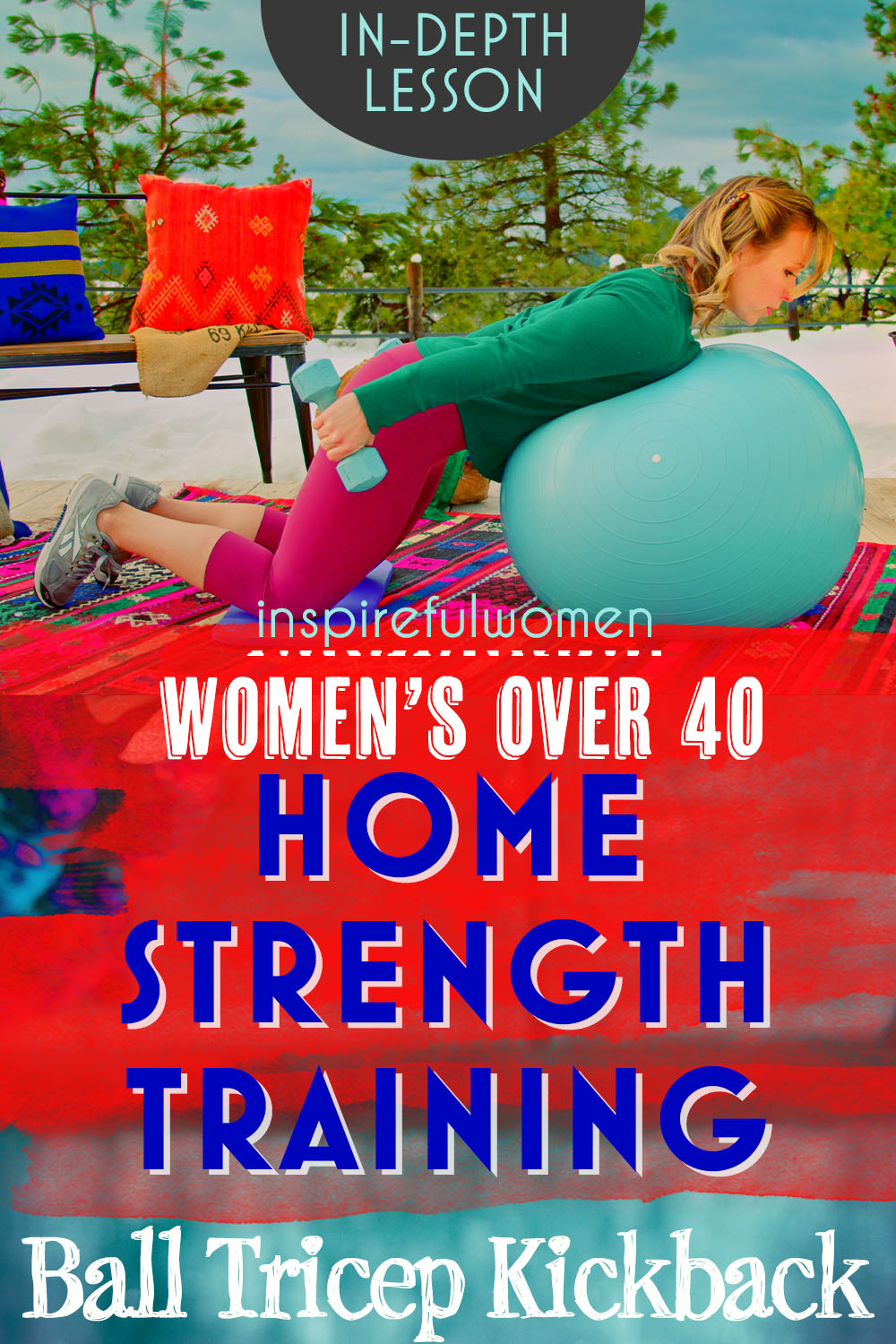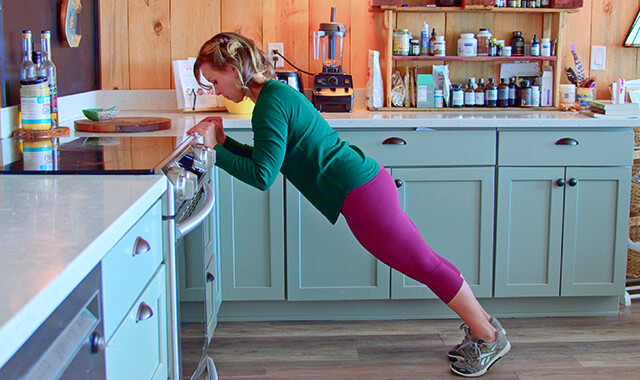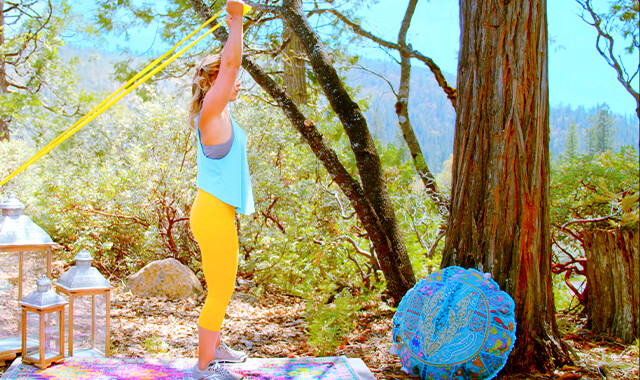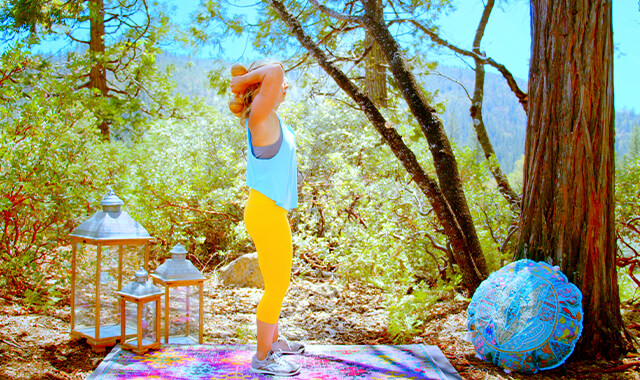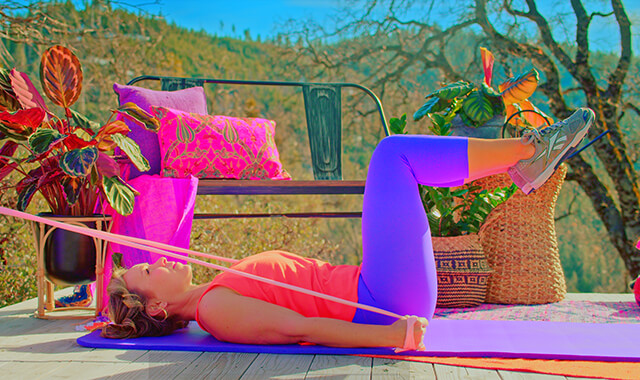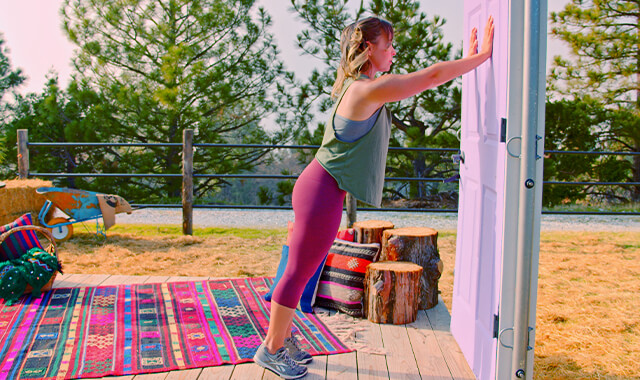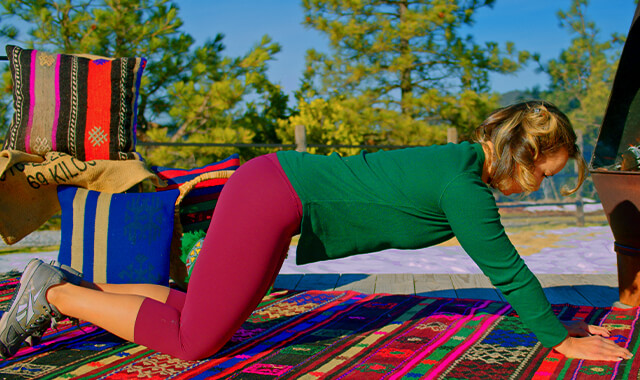Incline Triceps Kickback w/ yoga ball
How to Do the Incline Triceps Extension Variation on Ball with Dumbbells | In-Depth Guide [VISUAL LEARNERS] Intermediate
Proper Form & Common Mistakes | Home Resistance Training
WHAT DO YOU WANT TO SEE?
QUICK DEMO
QUICK DEMO
MUSCLES THIS WORKS
MUSCLES
MAIN MUSCLES WORKED IN the Incline Triceps Kickback
TRICEPS
OTHER MUSCLES WORKED:
- Anconeus (a forearm muscle)
STARTING POINTERS
Starting Pointers
WHAT WE'RE DOING TODAY
ALL WE'RE DOING:
Just bend and unbend the elbow, in a bent-over position.
Try this bat wing exercise for flabby arms. The incline triceps kickback with a yoga ball and dumbbells is performed to target the triceps muscles in a unique way. This variation of the triceps kickback involves performing the exercise while leaning on an inclined surface, such as a yoga ball, which increases the activation of the triceps muscles. This exercise can help to build strength, improve arm definition, and increase overall upper-body functionality.
The movement is leaning over, hinging at the hips to place the chest on the ball. A great replacement if you don't have access to those ugly stinky gym benches. Both arms will be working at the same time. This is a nice option if you find the unsupported versions don’t work well for you, or if you have difficulty leaning on one arm in the single-arm bench version.
The core muscles will not need to work very hard because the upper body is supported on the ball, but this may also make it easier for you to lift heavier dumbbells.
Depending on the size of your body and the ball you use, you may need to lift the upper arms higher to get them closer to parallel. This can work the mid back muscles a little bit more - the mid traps and the rhomboids. There will be a trade off with the starting position: The further the upper arm is lifted back into extension (past the torso) the less the long head of the triceps will be able to contribute to straightening the elbow. This is not good or bad, just information to use to meet your goals for the movement.
HOW TO DO THE EXERCISE
LOOKS
HOW Incline Triceps KickbackS SHAPE OUR BODY
Will tone and shape the triceps which is the biggest muscle of the arm. Firms the F word - flabby - upper arm region.
PROPER FORM
PROPER FORM: Ball Triceps Kickback
EQUIPMENT, SETS & REPS
EQUIPMENT
Stability Ball
SUGGESTED STARTING WEIGHT FOR WOMEN:
5-8 lbs
SETS & REPS:
2-3 sets of 8-10 reps
PACE:
Controlled straightening and bending of your elbow, straightening can be quicker than bending.
BODY POSITION
BODY POSITION FOR THE Incline Triceps Kickback
BODY STANCE: Kneeling with the ball in front of you, neutral spine. Shoulder blades in and down the back. Hinge at your hips to let your chest contact the ball. Your head is not in contact with the ball. The exact position will depend on your body and ball size. The goal is to try to get your torso close to parallel with the floor. Sternum lifted, broad chest (even if your chest is supported on the ball), shoulder blades in and down the back.
LEGS: Hips are over the knees, knees about hip-width apart. Knees and lower legs on the floor - any comfortable position.
ARMS: Upper arms pushed back - parallel to the floor, as close to your torso as possible. Elbows bent to 90 degrees or less - there is not much muscle activity at the beginning of the movement so if the weights are hitting the ball, first try lifting your upper arm back a little more or limit how much you bend your elbow.
HAND/GRIP: Palms facing each other (Neutral grip). Holding the handle of the dumbbell towards your head that is closest to the ball may help to prevent running into the ball when you bend at your elbows.
HOW TO DO
HOW TO DO Incline Tricep Kickback - Stability Ball & Dumbbell
CUE: Once your upper arm is in position, keep it still and isolate all of your movement to just your elbow joint.
Straighten your elbow to lift the dumbbell.
Straighten your elbow all the way, pause, and then lower back down to the starting position.
The starting position is when your elbow is bent to about 90 degrees - your hand straight down from your elbow.
HOW TO SAFELY GET OUT OF THE EXERCISE
Bring your upper arm down, reverse the hip hinge to come off of the ball, and return to standing.
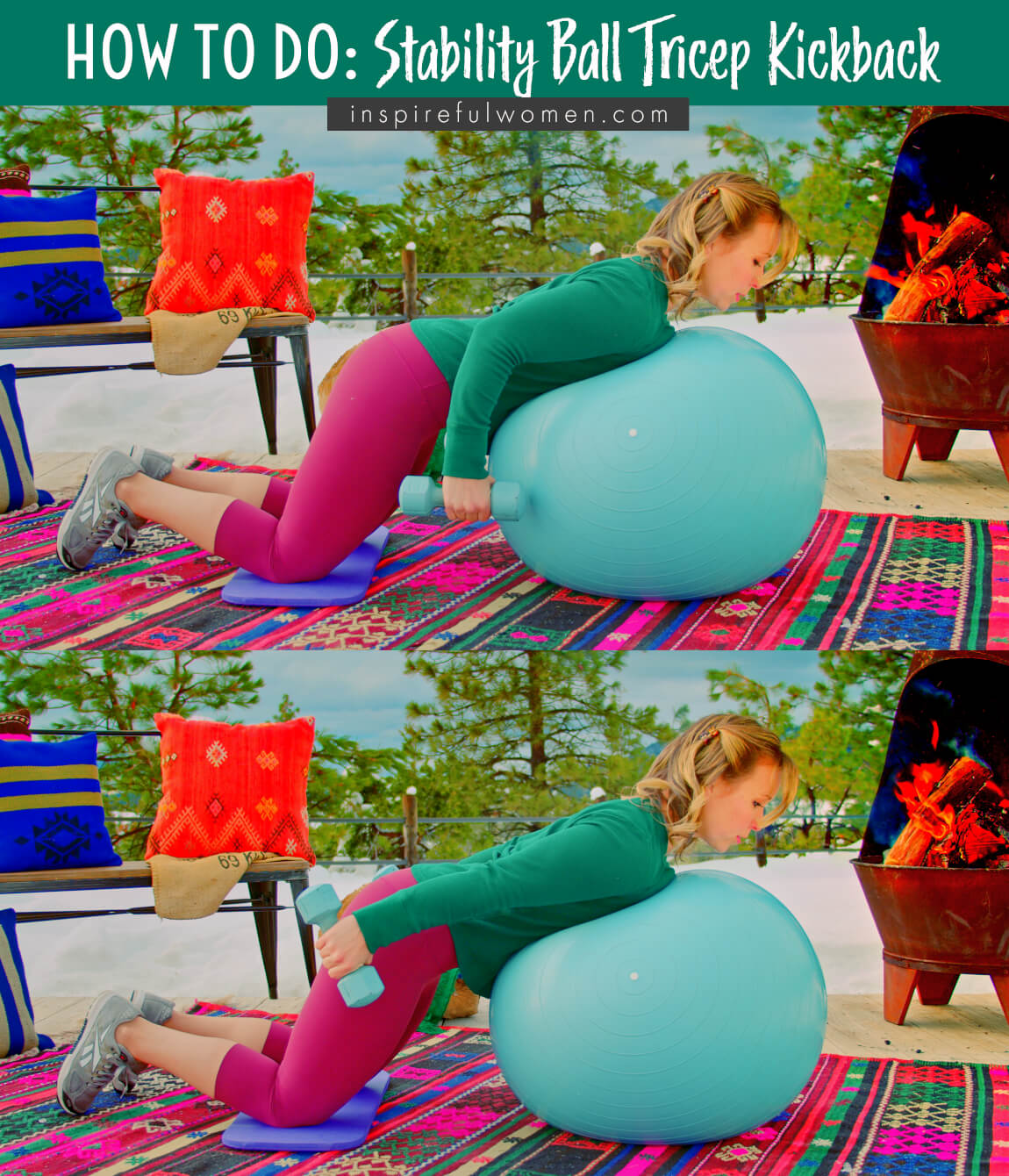
COMMON MISTAKES
COMMON MISTAKES
WHAT TO AVOID WITH THE Incline Tricep Kickback
KEY TIP:
Guess what? Good news! Many avoids are the same for most movements. Once you learn the basics, there's really only a few extra avoids for each individual movement.
1. Avoid Torso Too Vertical
AVOID: Avoid the torso being too vertical.
WHAT TO DO:
- The goal is to get your torso as parallel to the ground as you can so that the triceps are working against as much gravity as possible
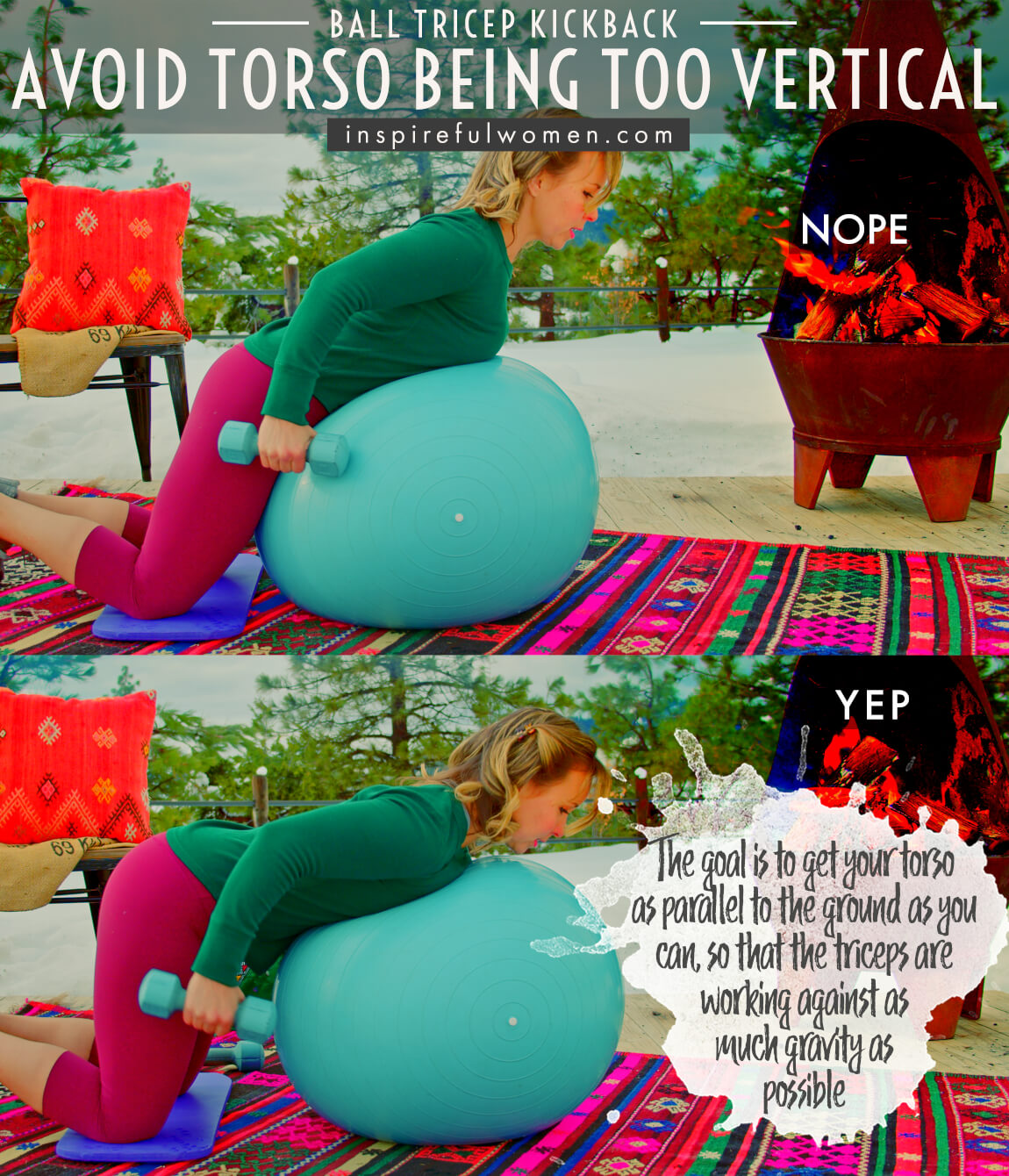
2. Avoid Arching Spine
AVOID: Avoid arching the spine.
WHY NOT?
- This can increase the stress on the joints of the spine
- Will also decrease the muscle activity of the muscles on the upper back that are important for good posture.
WHAT TO DO:
- Keep the spine neutral, the sternum lifted, and the shoulder blades should be back and down.

3. Avoid Moving Elbow
AVOID: Avoid letting the upper arm move up and down.
WHY NOT?
- This would be activating the latissimus dorsi and teres major and decrease the activity of the triceps.
WHAT TO DO:
- Keep your upper arm still, just move at the elbow.
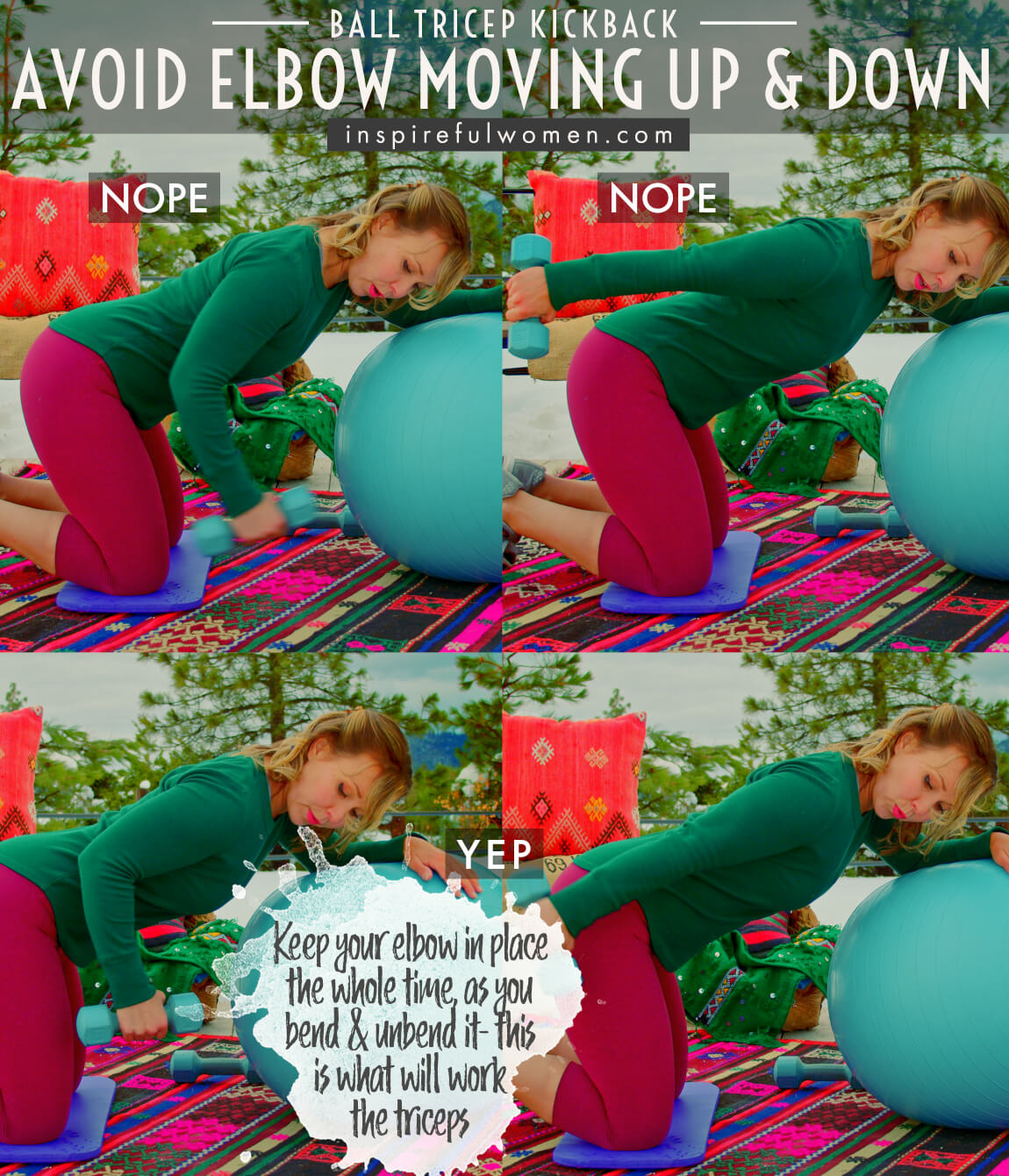
WHAT WE'RE DOING TODAY
WHAT & WHY
BENEFITS OF TRAINING THE triceps
WHAT
Tricep Kickbacks target the large muscle on the back side of the upper arm. The main function of this muscle is to straighten the elbow, like the movement that you make to push a door open. This is a very simple movement, just straightening the elbow and then controlling the movement of the arm as you the elbow bends again. This exercise is the compliment to bicep curls - the bicep curl works the muscle on the front and the tricep works the muscle on the back of the upper arm. If you do bicep curls, make sure to include some tricep exercises in your workout to keep the muscles well-balanced.
There are a few options for body position for tricep kickbacks. The main things to keep in mind are that you want the upper arm in line or slightly behind the body, and concentrate on isolating the movement to the elbow. This will work one part of the tricep - the long head, for both of its functions: moving the upper arm back and straightening the elbow.
The other thing to think about is the resistance of the muscle. With dumbbells, the resistance will be greatest when the upper arm is pushed back, running parallel to the floor and the elbow is fully extended. When you are using an elastic band, the resistance will be greatest when the band is stretched the longest and you are resisting the band pulling the upper arm forward and bending the elbow. Take a minute to think about your setup before completing the movement.
Muscles are the strongest when they are in the middle of their range of motion - not too short and not too long. This is important when you are setting up for the tricep kickbacks. If you do not lean your torso over far enough, you will need to lift the arm back further behind your torso to get it to be parallel to the floor. The further you lift the arm behind the torso - the shorter the long head of the tricep will be. This position will make it harder for the long head of the triceps to help to fully straighten the elbow. This is neither good or bad, but it may help you get the right body position to meet your goals.
WHY BOTHER DOING IT?
WHY
WHY DO WE EVEN CARE?
THE BIGGER ARM MUSCLES MEANS WE NEED THEM IN OUR LIFE
Since this is the largest muscle of our arm, it means we use it a LOT in everyday life to do stuff, especially anything that feels hard.
The word tricep means that there are three heads (or parts) to the muscle. All three heads of the muscle cross the elbow joint, with their primary function being to straighten the elbow. The long head of the tricep also crosses the shoulder joint. This part of the muscle can also help to pull the upper arm back, like the movement you would do to pull a cord down to open the shades.
WORKS ALL 3 HEADS OF THIS MUSCLE!
Tricep kickbacks work all three heads of the triceps and the anconeus - which is a small muscle in the forearm area that helps to straighten the elbow. These muscles are also important for stabilizing the elbow joint.
SPECIAL FOCUS ON THE LONG HEAD OF THE TRICEPS
The position of the triceps kickback is good for targeting the long head of the tricep. What I learned from Carol the physical therapist is that different arm positions will work each of the three heads in different ways. By positioning our arm a little differenty we can give a bit more focus to one of the three heads, which can be nice for really fatiguing that portion of the muscle, and is also what helps give nice shape to our arm.
When the arm is held back against resistance, the long head of the triceps is shortened at the shoulder joint and then, to straighten the elbow. This positioning keeps tension on the long head of the triceps throughout the movement. This is one of the few triceps exercises that do this, making it a nice way to add variety to your tricep training. When your upper arm is down by your side or raised up in front but less than shoulder level, the long head of the triceps will do most of the work to extend the elbow.
Most joints have muscles on opposite sides that do opposite movements. This is true for the elbow joint - the biceps bends the elbow and the tricep straightens the elbow. Bicep curls are probably one of the most common exercises, and sometimes the triceps are overlooked. Most functional use of the arms requires that the biceps and triceps work together in coordination to control the movement of the arm. Including exercises for both the biceps and triceps can help keep the muscles balance in order to keep the elbow joint healthy.
The anconeus is a pretty small muscle that crosses the elbow joint. The muscle does not have a lot of power, so it does not contribute much to extension. It does work to stabilize the elbow joint, especially to hold the forearm in a neutral position - between pronation and supination.
EVERYDAY LIFE
EVERYDAY LIFE &
MUSCLE FUNCTION
HOW WE USE OUR triceps IN EVERYDAY LIFE
1. STRAIGHTENS (EXTENDS) THE ELBOW
- Reaching with a straight arm
- Pushing a door shut, stroller, shopping cart
- Pushing up from a chair, floor, or lying down- on side
- Sports - provides power for swinging in golf and backhand shots in tennis
- Throwing - as the straightens
2. HELPS TO STABILIZE THE ELBOW JOINT - DURING ALL ARM USE
- Writing, eating, dressing, using a screwdriver
3. THE LONG HEAD OF THE TRICEPS ONLY (BECAUSE IT CROSSES THE SHOULDER JOINT):
- Extension (moving the arm back behind the body) and adduction of the shoulder (moving the arm in towards the midline
- Swimming
- Reaching the back pocket
- Putting a belt on
- Stabilization of the shoulder
- Holding the arm still while using the hand - writing, carrying objects, driving, pushing a wheelbarrow
HOW TO FEEL WHAT MUSCLE IS WORKING
How to Feel What Muscle is Working
Place the palm of your hand on the edge of a table or the wall with the elbow bent. Place your other hand on the back of your upper arm. Lean some of your weight onto the arm, and straighten the elbow. You will feel the triceps activate.
SCIENCY STUFF
ALLLL MUSCLES & WHEN
ALL MUSCLES WORKING & WHEN DURING THE Incline Tricep Kickback - Yoga Ball & Dumbbell
The scapular stabilizers work to hood the shoulder blades back and down throughout the exercise.
The long head of the triceps, the latissimus dorsi, and the teres major work isometrically to hold the upper arm in a slightly extended (just slightly behind) and adducted (close to the body) position to provide a stable base for the triceps to work off of.
All three heads of the triceps and the anconeus contract concentrically to straighten the elbow joint.
The muscles of the forearm work to hold the wrist in a neutral position.
The triceps and anconeus contract eccentrically to control the movement as the elbow bends and returns to the starting position.
PIN IT FOR LATER!

